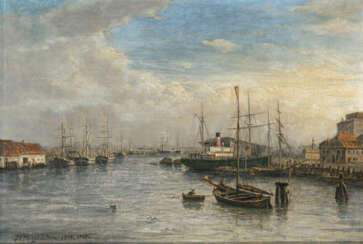stetti












Wilhelm Ohm, full name Wilhelm Friedrich Hubert Ohm, was a German painter, draftsman, sculptor and architect.
Ohm trained in architecture and worked as a government architect and engineer, and studied sculpture and mural painting at the Prussian Academy of Fine Arts in Berlin. From 1923 to 1933 he was a member of the North German Artists' Association. In 1940 Wilhelm Ohm received a Bachelor's degree from the Technical University of Berlin on the colorful redesign of cities, through which he wanted to combine painting and architecture into a unified whole. This idea occupied him throughout his life.
Wilhelm Ohm's work of the 1920s can be stylistically categorized as New Objectivity and Surrealism. After World War II, trying to make up for lost time, he saturates his paintings with color and energy. His later works were done in a post-impressionist style. This applies to his landscapes, nature studies, floral bouquets and fruit compositions.
Wilhelm Ohm's son August Ohm, born in 1943, also became an artist.


Wilhelm Ohm, full name Wilhelm Friedrich Hubert Ohm, was a German painter, draftsman, sculptor and architect.
Ohm trained in architecture and worked as a government architect and engineer, and studied sculpture and mural painting at the Prussian Academy of Fine Arts in Berlin. From 1923 to 1933 he was a member of the North German Artists' Association. In 1940 Wilhelm Ohm received a Bachelor's degree from the Technical University of Berlin on the colorful redesign of cities, through which he wanted to combine painting and architecture into a unified whole. This idea occupied him throughout his life.
Wilhelm Ohm's work of the 1920s can be stylistically categorized as New Objectivity and Surrealism. After World War II, trying to make up for lost time, he saturates his paintings with color and energy. His later works were done in a post-impressionist style. This applies to his landscapes, nature studies, floral bouquets and fruit compositions.
Wilhelm Ohm's son August Ohm, born in 1943, also became an artist.


Wilhelm Ohm, full name Wilhelm Friedrich Hubert Ohm, was a German painter, draftsman, sculptor and architect.
Ohm trained in architecture and worked as a government architect and engineer, and studied sculpture and mural painting at the Prussian Academy of Fine Arts in Berlin. From 1923 to 1933 he was a member of the North German Artists' Association. In 1940 Wilhelm Ohm received a Bachelor's degree from the Technical University of Berlin on the colorful redesign of cities, through which he wanted to combine painting and architecture into a unified whole. This idea occupied him throughout his life.
Wilhelm Ohm's work of the 1920s can be stylistically categorized as New Objectivity and Surrealism. After World War II, trying to make up for lost time, he saturates his paintings with color and energy. His later works were done in a post-impressionist style. This applies to his landscapes, nature studies, floral bouquets and fruit compositions.
Wilhelm Ohm's son August Ohm, born in 1943, also became an artist.


Wilhelm Ohm, full name Wilhelm Friedrich Hubert Ohm, was a German painter, draftsman, sculptor and architect.
Ohm trained in architecture and worked as a government architect and engineer, and studied sculpture and mural painting at the Prussian Academy of Fine Arts in Berlin. From 1923 to 1933 he was a member of the North German Artists' Association. In 1940 Wilhelm Ohm received a Bachelor's degree from the Technical University of Berlin on the colorful redesign of cities, through which he wanted to combine painting and architecture into a unified whole. This idea occupied him throughout his life.
Wilhelm Ohm's work of the 1920s can be stylistically categorized as New Objectivity and Surrealism. After World War II, trying to make up for lost time, he saturates his paintings with color and energy. His later works were done in a post-impressionist style. This applies to his landscapes, nature studies, floral bouquets and fruit compositions.
Wilhelm Ohm's son August Ohm, born in 1943, also became an artist.


Friedrich Ernst Morgenstern was a German painter, son of the landscape painter Karl Morgenstern. He studied painting with Johann Heinrich Hasselhorst, Gustav Kaupert and Eduard von Steinle at the Städelsche Kunstinstitut.
Friedrich Ernst Morgenstern undertook several study trips to Holland, Belgium, France, Italy, England and Scotland. Only after his father's death, in 1893, did he succeed in developing his own impressionistic style and artistic expression. The painter did not belong to the Kronberg artists' colony, but maintained friendly ties with them.




Wilhelm Ohm, full name Wilhelm Friedrich Hubert Ohm, was a German painter, draftsman, sculptor and architect.
Ohm trained in architecture and worked as a government architect and engineer, and studied sculpture and mural painting at the Prussian Academy of Fine Arts in Berlin. From 1923 to 1933 he was a member of the North German Artists' Association. In 1940 Wilhelm Ohm received a Bachelor's degree from the Technical University of Berlin on the colorful redesign of cities, through which he wanted to combine painting and architecture into a unified whole. This idea occupied him throughout his life.
Wilhelm Ohm's work of the 1920s can be stylistically categorized as New Objectivity and Surrealism. After World War II, trying to make up for lost time, he saturates his paintings with color and energy. His later works were done in a post-impressionist style. This applies to his landscapes, nature studies, floral bouquets and fruit compositions.
Wilhelm Ohm's son August Ohm, born in 1943, also became an artist.















![36 progetti di ville di architetti italiani, a cura dell'Esposizione Triennale Internazionale delle Arti Decorative Industriali Moderne alla Villa Reale di Monza, | Bestetti e Tumminelli, Milano [1930].. Fabric binding. (23x29x3.5 cm.) (slight defects)](/assets/image/picture_2902897/d7c70/jtocajvo8vv4m-xmqrqse7zwy2qp912lhmsqsjakfe8jy148eyq6blrnjnzdkzf1686080632jpg__fix_374_244.jpeg)
![36 progetti di ville di architetti italiani, a cura dell'Esposizione Triennale Internazionale delle Arti Decorative Industriali Moderne alla Villa Reale di Monza, | Bestetti e Tumminelli, Milano [1930].. Fabric binding. (23x29x3.5 cm.) (slight defects)](https://veryimportantlot.com/assets/image/picture_2902897/d7c70/jtocajvo8vv4m-xmqrqse7zwy2qp912lhmsqsjakfe8jy148eyq6blrnjnzdkzf1686080632jpg__fix_374_244.jpeg)

























































